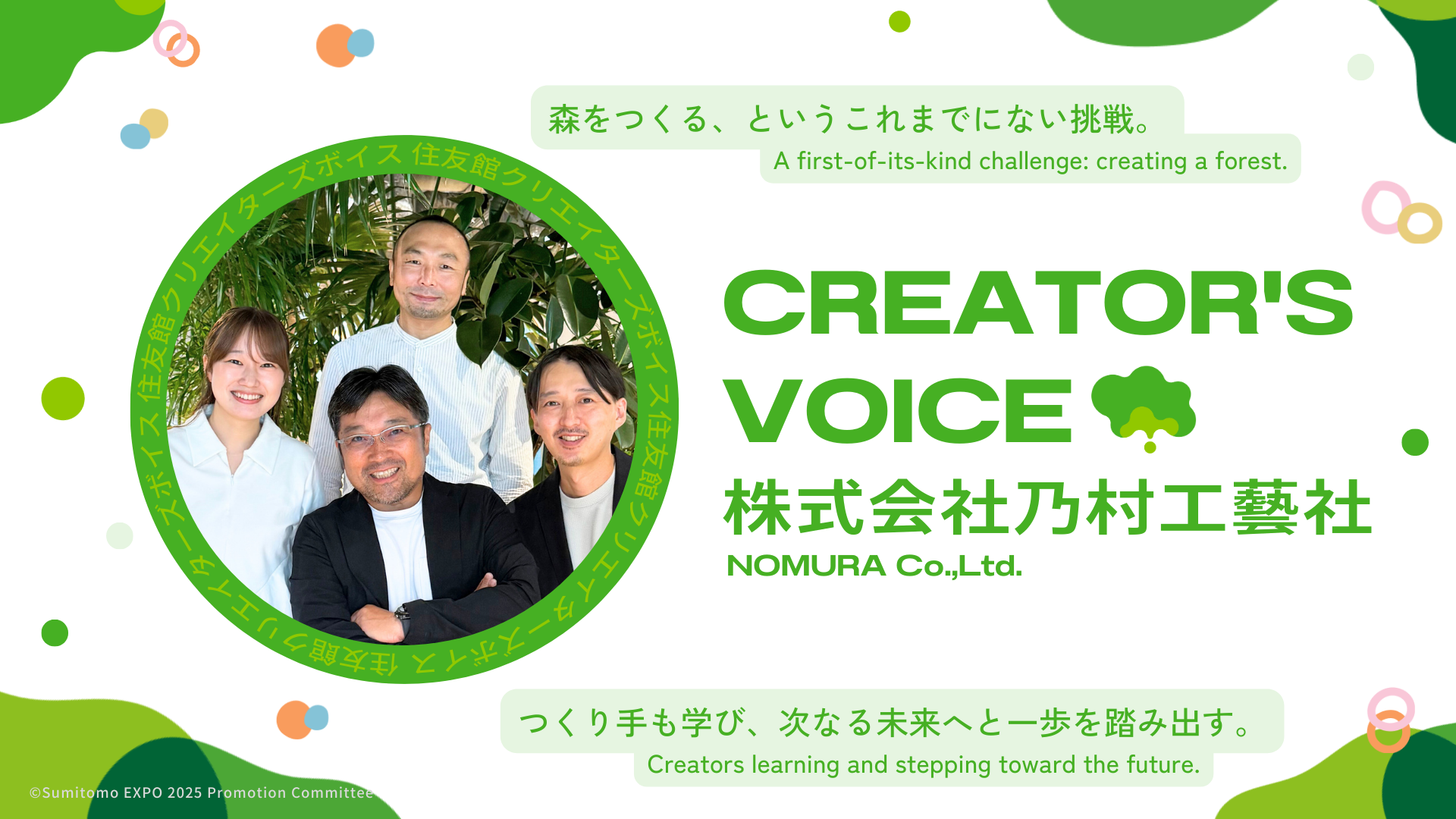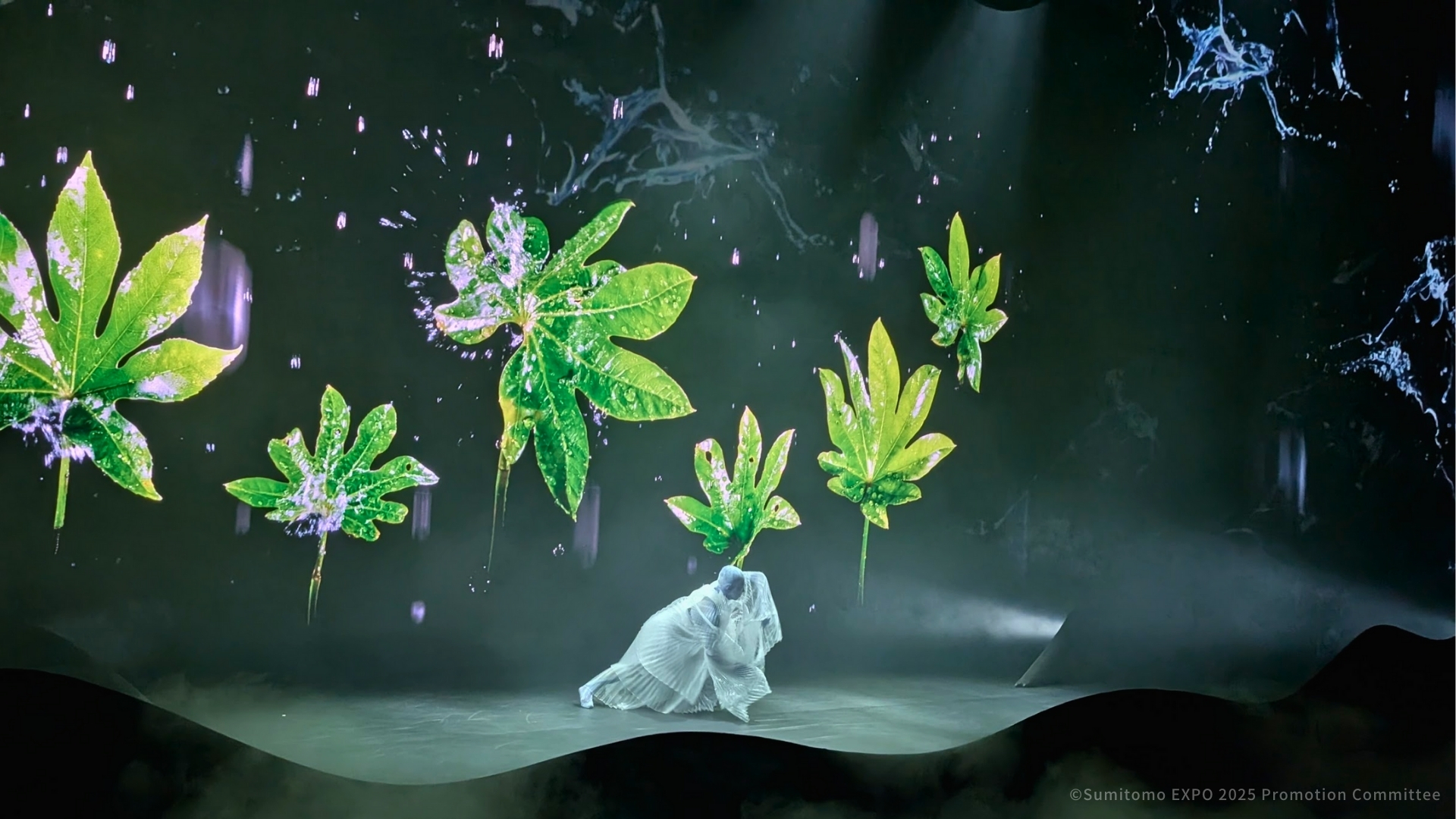
Sumitomo Pavilion Creator’s Voice Vol.7 NOMURA Co.,Ltd.
Hello, this is the Sumitomo Pavilion.
In this series, Sumitomo Pavilion Creators’ Voice, we introduce the voices of creative staff involved in the pavilion’s exhibitions, architecture, and production—one story at a time.
It’s a collection of personal narratives filled with passion for the Expo and the Pavilion, challenges overcome, and uncompromising dedication.
This time, we spoke with four members from Nomura Co., Ltd., the team behind the creation of the Sumitomo Pavilion’s spatial experience: Hirotaka Tamura, Eiji Kawasaki, Yasushi Machida, and Yuka Katahira.
<Profile>
Nomura Co., Ltd. is a comprehensive spatial production company that handles everything from planning and design to construction and operational management for spaces such as commercial facilities, hotels, corporate PR venues, workplaces, museums, and entertainment venues.
Since its founding in 1892, Nomura has delivered “joy and inspiration” to people by leveraging the all-around capabilities it has cultivated over more than a century.
In the realm of expositions, Nomura has been involved in the design and production of a wide variety of pavilions, beginning with Expo 1970 in Osaka. For Expo 2025 Osaka, Kansai, the company has combined the wisdom passed down from past pioneers with cutting-edge technology and masterful spatial craftsmanship to create a one-of-a-kind immersive experience.
https://www.nomurakougei.co.jp/
What brought you to the Sumitomo Pavilion project?
Tamura:
In the fall of 2021, just before Expo 2020 Dubai opened, I was invited by General Producer Naito to handle the space design for the Sumitomo Pavilion. Until then, I had worked on large-scale events such as motor shows and complex projects like the latest ballparks that required a broad range of expertise. But this was actually my first Expo project. While I was confident I could meet expectations, I also felt as though my career so far was about to be put to the test.
Kawasaki:
I’d call it fate, honestly. My father worked for the Sumitomo Group, and my younger brother still does. Back at Expo 2005 Aichi, my role was limited to areas within my specialty, as I was still inexperienced. In contrast, the Sumitomo Pavilion demanded that everything be created from scratch. It required a “commitment” to stay engaged in planning and design for over three years—an overwhelming amount of time. At first, I was bewildered, but gradually, I began to look forward to it as an opportunity to put my 20 years of design experience since Expo 2005 to the test.
A first-of-its-kind challenge: creating a forest.
Katahira:
I joined the project shortly after entering the company. I was told, “The Sumitomo Pavilion will create a forest. That’s the only thing decided so far.” At that time, the forest plan was a completely blank slate. I had no idea how we would bring it to life, so I felt both excitement and uncertainty.
One of my most memorable experiences was joining the regular planning meetings right away. Specialists from various fields gathered weekly to discuss how we could deliver a better visitor experience. At times, we conducted trial assemblies to test ideas. Witnessing the uncompromising process of shaping the space step by step was incredibly inspiring.

Tamura:
Since it was decided from the start that the pavilion would have a forest theme, I visited forests all over Japan to study their vegetation and natural formation.
When I drew concept perspectives using conventional space design methods, the forest inevitably looked flat—more like a park. So, I abandoned the usual approach of deriving perspectives from floor plans or elevations, and instead drew the scene first—like recreating a movie still—before drafting the plans. Learning this method became a significant takeaway for my future entertainment space design work.


Machida:
When creating the forest, our aim was a space with varied terrain—like a real forest—not a flat, park-like one. Of course, because this was an indoor forest, we had to comply with building laws and association guidelines. We sought ways to ensure the experience remained engaging for all visitors.
In addition to accessible paths, we intentionally designed multiple routes, such as steep slopes and hidden areas that could only be seen by climbing stairs. I also wanted to include places you couldn’t reach alone but could get to with the help of family or friends.

Kawasaki:
The challenge was to pursue “realism” within limited conditions. Usually, in immersive spaces, visitors’ movement is clear, and we design ways to guide them. But the Sumitomo Pavilion’s forest was designed in the opposite way—“you can’t see where you’re going, you don’t know where you are, you can’t find what you’re looking for.” In retrospect, our guiding principle was to let visitors get lost in the forest.
Also, rather than relying solely on common projection effects, we incorporated high-quality animatronic animals—an element that significantly enhanced the realism and charm of the forest.
The joy of seeing our attention to detail reach visitors.
Tamura:
Until right before opening, I was so focused on the pavilion that I had no idea how other pavilions looked. I was surprised to see the Sumitomo Pavilion become so popular. Seeing the reactions from international visitors and children made me truly happy to know that our intended message was reaching people.
Machida:
I’ve been amazed by the feedback, both in person and on social media. Seeing young children delighted is especially heartwarming. There were many challenges, but visitors’ smiles make me feel it was all worth it.
Kawasaki:
I’ve often been told “That was amazing!” at the pavilion exit, which really confirms we created something special. I’m also impressed by the team’s dedication to keep evolving the pavilion until the very end—adding more animals, more photo spots, and even new events despite its popularity. I’ve realized that a popular Expo pavilion is something that changes like a living organism.
Katahira:
I’ve heard from many people about the pavilion’s success, but one comment stood out: “You can feel the attention to detail in every corner!” It’s rewarding to know that everything we worked hard to create is resonating with visitors.
Wandering, sensing, and connecting the dots.

Tamura:
UNKNOWN FOREST is designed so everyone—from wheelchair users to visitors of all ages—can safely enjoy the adventure. In a way, it’s an “unnatural” forest, filled with devices that heighten your senses and draw you into immersion. Yet visitors often find themselves so absorbed that they feel as if they’ve wandered into a real forest. If that experience sparks their imagination and makes them curious about the stories of creatures in an actual forest someday, I’d be delighted.

Kawasaki:
Creating the animals in the Earthen Corridor was challenging, but hearing visitors say, “I saw the fox—now I’m happy!” made it all worth it. I hope children who spot animals or insects here will be inspired to visit real forests. I even secretly hope an urban legend will start—something like “I heard they keep a fox in the Sumitomo Pavilion.”

Machida:
The Performing Theater is a layered stage composed of front and rear projections and set pieces, allowing visitors to enjoy three-dimensional effects up close. Since the view changes depending on where you sit, I’d encourage future visitors to try different seats.

Katahira:
UNKNOWN FOREST hides many forms of life—animals, insects, plants. At the end of the experience, we provide a display revealing where they were hidden. I hope this “answer check” becomes one more reason for people to return.
Creators learning and stepping toward the future.
Tamura:
I was reminded of the power and value of real spaces. In an era where COVID-19 and social media have shifted us toward virtual communication, seeing so many people gather, share experiences, and exchange thoughts in person reaffirmed the importance of physical spaces. At the same time, I learned from the pavilion’s story-driven architecture—made from trees of the Sumitomo Forest—that spaces must have meaning and positive influence, or they risk being just environmental burdens.
Kawasaki:
I’ve learned so much here. While I’ve worked on architecture and exhibitions before, this project showed me the precise processes—and relentless refinement—needed to create an experience. I want to bring that drive to future projects that move visitors emotionally. As for what’s next—maybe the ocean? It’d be amazing to work with the same team again, but I’ll leave that to fate.

Machida:
We planned this for a long time, but it wasn’t until visitors entered and the performances began that I felt I truly saw the whole forest. Hearing visitors’ reactions firsthand was invaluable. I want to keep considering what we can communicate and what visitors can feel.
Katahira:
This project taught me so much—the process of creating something unknown, the uncompromising standards. Collaborating with seasoned veterans and peers alike was inspiring. I treasure these connections and look forward to working together again.
